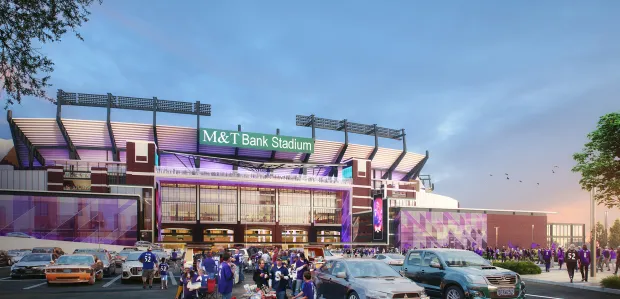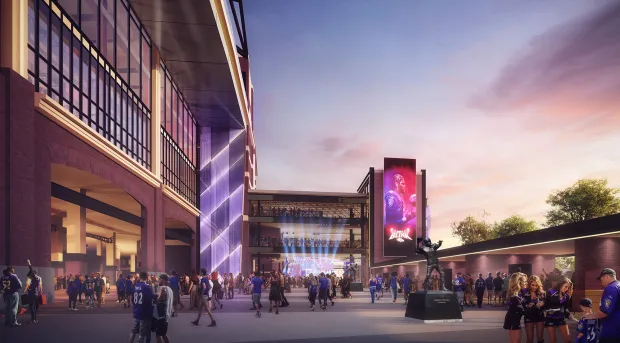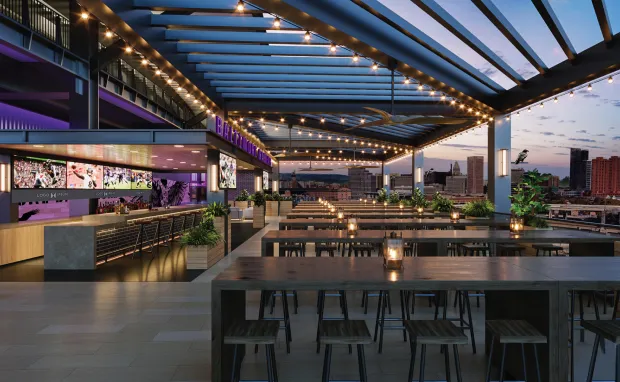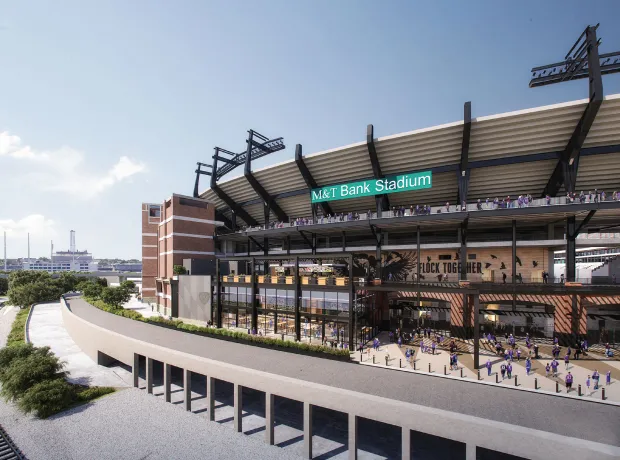Ravens’ $430M state-funded stadium upgrades to roll out in 2024, include 3 plazas, expanded concourses
Corenic Construction is thrilled to announce our partnership with Gilbane for the renovations of the M&T Bank stadium. This project is a significant milestone for us, and we are truly excited to play a major role in its success.
_________________________________________________________________________________________________________________
The Baltimore Sun

By HAYES GARDNER | hgardner@baltsun.com
PUBLISHED: December 12, 2023 at 11:00 a.m. | UPDATED: December 12, 2023 at 6:29 p.m.
M&T Bank Stadium will soon undergo its most substantial makeover since it opened in 1998.
Equipped with a large fund of state dollars, the Ravens and the Maryland Stadium Authority unveiled plans Tuesday to renovate the 71,008-seat venue. Some improvements will be finished by August 2024, ahead of the start of next year’s regular season, while others are scheduled to be completed ahead of the 2025 and 2026 campaigns. By the end, three plazas with bars and retail stores will surround the stadium and greet fans on game days, the upper concourses will be expanded by several thousand square feet to decrease foot traffic, and premium seating will be added next to the field and above the lower level, where the press box currently sits.
The renovations will cost the state at least $430 million over the three years.
That money comes from a 2022 law passed by the General Assembly and then-Gov. Larry Hogan, which permitted the stadium authority to issue $600 million in bonds for improvements to each of Baltimore’s two pro sports stadiums, provided the Orioles and Ravens, which operate as tenants of the state, signed long-term leases. By agreeing in January to a lease until at least 2037, the Ravens unlocked their share of those state funds and have worked with the stadium authority as well as Gensler, an architecture firm, and Gilbane, a construction company, on those plans.
“We want to make sure with such a significant investment that we really impacted and enhanced the experience for all of our fans,” Ravens president Sashi Brown told The Baltimore Sun.
The bulk of the improvements will be completed ahead of the 2025 season, but by 2024, fans will see some additions, including a two-level beer hall, dubbed The Gatehouse, on the east side of the stadium. Similar to rowhouses in many Baltimore neighborhoods, the bar will feature a roof deck with string lights.
“It will look out over Fed Hill toward the Inner Harbor. So that’s going to be awesome,” Brown said.
That will be the first of three plazas. Ahead of the 2026 season, the Ravens will add an 8,000- to 10,000-square-foot retail store, open year-round, on the south side, and in 2025, two large structures — the marquee addition of the remodel — will flank the gates on the north side, next to the statues of Ray Lewis and Johnny Unitas. That plaza, billed as the “Grand Entrance to M&T Bank Stadium” by the Ravens, will have a stage, a sports bar, a tailgate area, as well as a team store and some sort of element highlighting the team’s history.

A rendering of upcoming renovations coming to M&T Bank Stadium. (Baltimore Ravens/Courtesy)

A rendering of upcoming renovations coming to M&T Bank Stadium. (Baltimore Ravens/Courtesy)

A rendering of upcoming renovations coming to M&T Bank Stadium. (Baltimore Ravens/Courtesy)

A rendering of upcoming renovations coming to M&T Bank Stadium. (Baltimore Ravens/Courtesy)

A rendering of upcoming renovations coming to M&T Bank Stadium. (Baltimore Ravens/Courtesy)

Show Caption
“We’re creating a new front door to M&T Bank Stadium,” Ravens senior vice president of marketing Brad Downs said.
Traditional tailgating will continue in parking lots, but the plazas will likely entice some fans to spend their pregame hours in bars attached to the stadium.
“As you know, the beer is colder and the hot dogs taste better here in our footprint, so we want to make sure we extend that,” said Rich Tamayo, Ravens senior vice president of stadium operations and guest experience.
The plazas will generally not be open year-round but could be rented out for private events or host watch parties for Ravens road games. They will be open on game days for all fans, but some upgrades to the stadium will only be enjoyed by a select few.
The press box — located at midfield just above the first level, one of the most coveted views of the field — will be relocated in 2024 to the southeast corner. In its place will be 10 suites and an exclusive adjoining club, which will have a “speakeasy” feel, the Ravens said in a news release, with “concierge service, high-end food and beverage options, mixologists at the bar, featured cocktails, a special selection of bakery items from a pastry chef and more.”
“It’s going to be a really exciting space that will allow our big corporations who are now up on the third floor get a little bit closer to the action and have an elevated experience for them and their guests on game day,” Brown said.
Field suites and lower-level clubs that will “get you feet from the action,” Brown said, will also be added in 2025.
The Ravens surveyed fans’ preferences and, as a result, will also plan to add more bathrooms and conditioned spaces for all attendees to avoid the elements. Adding a roof was never seriously considered — it would be prohibitively expensive and, Brown said, the Ravens enjoy the element of playing outside.
The upper concourse will also be expanded in 2025 to improve the flow of foot traffic and, at off-peak times, become a place to socialize.
Tens of millions of dollars worth of renovations will be infrastructure-focused, but Brown said that, because the stadium has been well cared for, much of the investment will go toward fan-facing improvements.
“It’s a tribute to M&T [Bank Stadium]. It was constructed really well, it’s been maintained really well and it’s stood the test of time. It’s still a beautiful stadium and, with the investments that we’ve made in it, it doesn’t feel like it’s dated and the infrastructure is strong,” he said.
At 25 years old, M&T Bank Stadium is one of the older NFL stadiums. The Tennessee Titans’ stadium, which opened a year after Baltimore’s, will soon be replaced by a $2.1 billion venue paid for with public and private dollars.
The Ravens announced their upcoming projects Tuesday with a news conference at M&T Bank Stadium, complete with a band and dancers greeting attendees. Brown, alongside Ravens executives, Gensler’s Global Director of Sports Ryan Sickman, and stadium authority Chair Craig Thompson, outlined the plans.
“Quite frankly, I’ve not been this excited in a while about looking at pictures,” Thompson said afterward, referencing displayed renderings. “Knowing what they represent in terms of the hard work of [stadium authority vice president of capital projects] Phil Hutson, his team, the MSA, the partnership, is really sort of a long time coming.”
The improvements, as scheduled, would still leave nearly $170 million (of the $600 million) in state finances for the Ravens to potentially use later.
“These are public dollars. [We] want to make sure we’re careful and thoughtful and efficient with the investment. And we’ve worked well with MSA to get to, I think, a really good place that will be very impactful across the stadium and the fan experience as a whole,” Brown said.
The state of Maryland paid for the construction of M&T Bank Stadium in the 1990s and, since then, the Ravens have paid for maintenance and operation costs, but not rent to the state. By playing in a publicly owned stadium, the team enjoys other benefits such as not having to pay property taxes — which would have been at least $176 million since it was built, according to one estimate — but has also invested almost $250 million of its own money in capital improvements, Brown said.
Some observers have said the state could better spend its money on other needed projects aside from stadium improvements. At an event Monday evening focused on rehabilitating vacant properties, the Rev. Andrew Connors said, “If we can find close to $1.5 billion in lean times for our football and baseball teams,” before being interrupted by applause.
“If we can find hundreds of millions of dollars in public money for the Inner Harbor for a second time,” he continued, “then we all know we can find the money for a first-time investment in our neighborhoods.”
Mayor Brandon Scott, who attended Monday evening’s event on rehabilitating vacant properties and Tuesday’s stadium news conference, said that this is a “both-and” situation, meaning government can support neighborhoods as well as the stadiums.
“The state of Maryland owns this building [M&T Bank Stadium],” Scott told The Sun on Tuesday. “This is the government investing in its own asset and allowing it to benefit all of the city. We do not have to make these false choices.”
Asked about the argument that public money could be spent more wisely elsewhere, Brown noted that the team generates tax revenue for the state, as well as ancillary benefits and publicity.
“The direct benefits of us being here, with the tax revenue that we generate, with the investment that we’ve made alongside the state into the stadium, is a really positive story,” Brown said.
Economists routinely argue against subsidies for privately owned pro sports teams, saying taxpayer dollars could be better served toward education, transportation or even tax breaks.
The stadium authority will issue bonds and borrow money from JPMorgan Chase to finance the upcoming improvements, which will ultimately be paid off over at least a decade with lottery revenue. The stadium authority board has recently discussed and approved some of the renovations and, in May, the Board of Public Works approved the plan to borrow up to $450 million.
“We are pleased and very, very excited to be able to advance this item today,” Gov. Wes Moore, who chairs the three-person board, said at the time, “to ensure that M&T Bank Stadium will continue to serve as a vital cultural, a vital economic and a vital entertainment asset for Baltimore, and also for the state of Maryland, for years to come.”
The Orioles have not accessed their portion of the funds for Camden Yards because they have not yet signed a long-term lease, after an agreed-to deal came to a halt Friday. Their current lease with the state expires Dec. 31.
Baltimore Sun reporter Emily Opilo contributed to this article.


